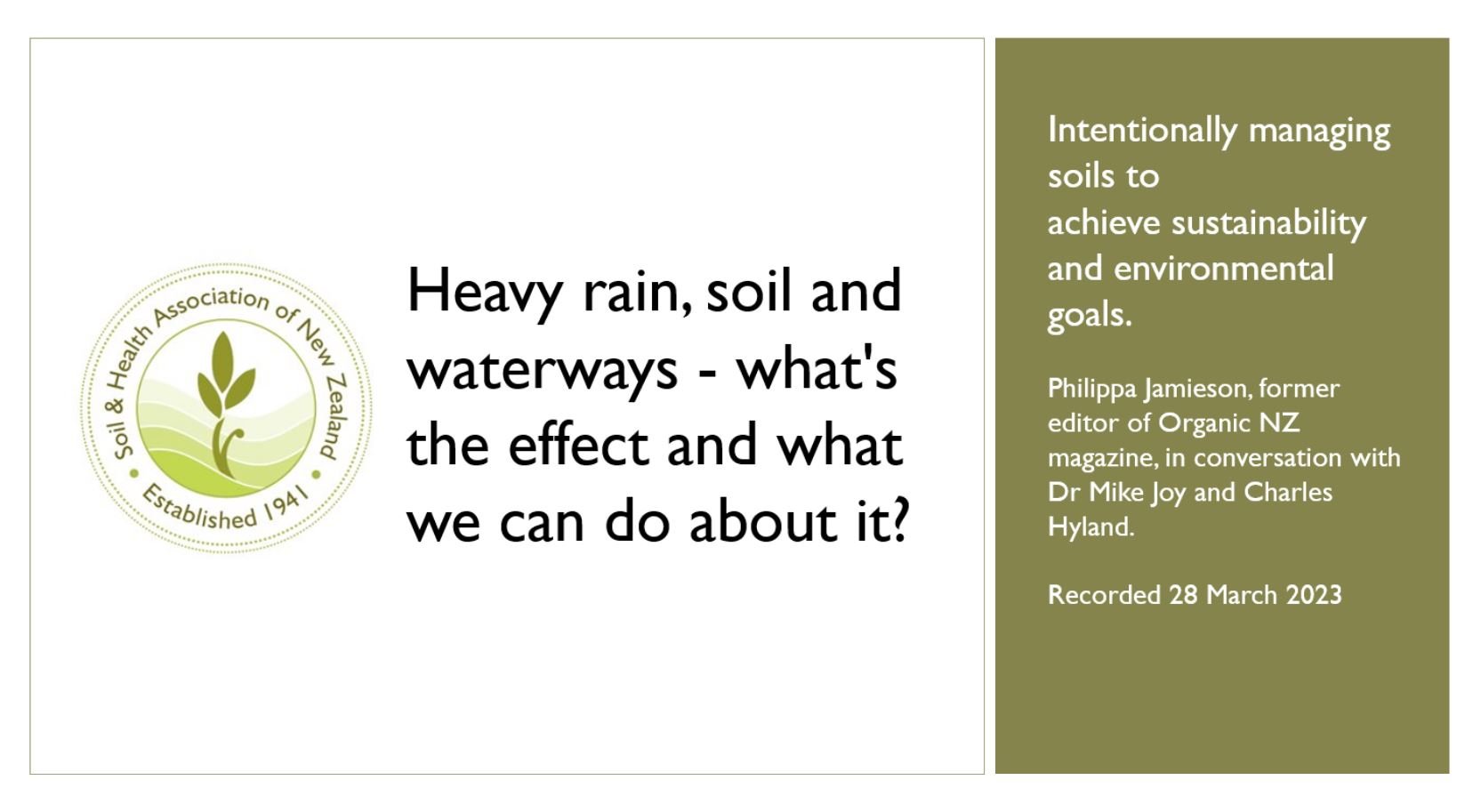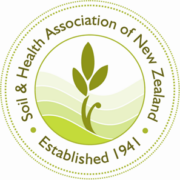Clean Water Consultation 2017
Clean Water Consultation 2017
Ministry for the Environment
PO Box 10362
Wellington 6143
Clean Water Consultation 2017
- This submission is on behalf of the Soil & Health Association of New Zealand Inc. (“Soil & Health”). Soil & Health was incorporated under the Incorporated Societies Act 1908 on 4 December 1942. Soil & Health’s objectives broadly include soil health and the promotion of organic gardening and farming. It has approximately 3000 members, chiefly composed of home gardeners and consumers, organic farmers and growers, secondary producers, retailers and restaurateurs. Its age and membership make it the oldest and largest representative organic organisation in New Zealand.
- Soil & Health appreciates the opportunity to comment on the consultation document Clean Water Package 2017 (Consultation Document).
Overview
- Soil & Health supports a number of underlying concepts in the Consultation Document and National Policy Statement Freshwater Management (NPSFM) and believe that they have the potential to improve the management of freshwater in New Zealand. These include proposals for “swimmable rivers”, stock exclusion, clarification of “maintain or improve”, and the use of MCI (macroinvertebrate community index), DIN and DRP.
- However Soil & Health has concerns with how the above proposals are to be incorporated. For environmental limits-based water management to be successful central government needs to install clear, directive, policy at a national level. Further the Consultation Document does little to address the issues of stock density and the excess application of nutrients on farms which leach through soils and into waterways.
- The government has failed to take the steps necessary to prevent the freshwater crisis effectively leaving waterways across the country in a dire state and continuing to deteriorate. This is reflected in the National Policy Statement on Freshwater Management (NPSFM) which sets bottom lines at levels which are toxic to aquatic life. These bottom lines have been incorporated into regional plans, leaving no prospect that water quality in rivers will ever return to ecological health.
- Further the main factor in the deterioration of waterways is due to nitrogen and phosphate pollution from the increasing intensification of (non-organic) dairy farming, which the government continues to actively promote.
- Various mitigating measures that the government has so far suggested, including in this Consultation Document, such as fencing off waterways, planting stream banks, and establishing initiatives like the Clean Streams Accord and Healthy Rivers, for the most part, are only bandaids that attempt to address the symptom and do little to address the actual cause of the problem – that being the excess application of nutrients and in the wrong form. An estimated 750,000 tonnes of urea was applied in 2014 the majority of which was onto dairy farms. This is a 38-fold increase from the 20,000 tonnes applied in 1983.
- Soil & Health strongly advocates for a transition to organic farming as part of the solution to fixing polluted fresh waterways in New Zealand. Organic dairy farming involves no soluble nitrogen fertilisers, lower stock numbers, more biodiversity, and grass-fed cows with no GE feed or palm kernel supplements.
Detailed submissions
Macroinvertebrate Community Index
- Policy CB1 requires regional councils to monitor macroinvertebrate communities. Soil & Health considers this requirement to be weak and not directive. The requirement does not implement the Land and Water Forum’s (LWF) recommendations that (in summary):[1]
- Plans be required to have a trigger for action if there is a downward trend in MCI, or it is below 100.
- The required action is to investigate and develop an action plan to either maintain or improve MCI scores in the water body. The key points in this process are:
- If the natural state is below 100, then the requirement is to maintain MCI at that level.
- If the MCI score in a water body is below 100 for human-induced reasons, then the requirement is to develop an action plan to improve the MCI score.
- If there is a downward trend in MCI then the requirement is to develop an action plan to reverse the trend.
- The LWF’s recommendations are based on advice given from a panel made up of independent scientists that MCI is scientifically robust and fit for purpose.
Relief:
- MCI and the planning system proposed above be incorporated into the NPSFM as per the LWF’s recommendations.
Dissolved inorganic nitrogen and dissolved reactive phosphorus
- The Consultation Document incorporates the setting of maximum concentrations of DIN and DRP through a “note” attached to the ecosystem health periphyton attribute table. This requirement is not sufficiently directive, and its legality and enforceability is unclear. It does not accord with or implement the LWF’s recommendations that (in summary):[2]
- The NPSFM include a requirement to set instream concentrations for DIN and DRP as objectives in regional plans.
- The development of a mandatory decision support tool to be used by regional councils to derive and set DIN and DRP concentrations.
- Research and develop a multivariate “look-up” table for DIN and DRP concentrations.
- The NPSFM incorporate nitrogen and phosphorus standards in order to achieve ecosystem health as measured through a desired MCI.
Relief:
- The NPSFM be amended to include setting of DIN and DRP concentrations in the NOF at ecosystem health levels.
- That a decision-support tool as per the flow chart attached to the LWF’s letter to Ministers of 19 August 2016 be confirmed and appended to the NPSFM. The text of the NPSFM must make clear that setting of DIN and DRP concentrations is to follow that process.
Gaps
- The NPSFM Consultation Version does not reflect the full range of attributes that need to be managed. The most important missing parameters are:
- Excessive sediment runoff from land is seen to be one of the main causes of water quality issues in New Zealand. Sediment however is not explicitly addressed in the Consultation Document. The four modes of impact from sediment are visual clarity, light penetration, suspended sediment concentrations, and deposited sediment. These are all capable of being included as attributes in the NOF.
- Stormwater drains from roads and other impermeable surfaces like roofs contain dissolved metal contaminants such as zinc and copper. Another more potent source is from motor vehicle tyre and brake wear on cars. These heavy metal contaminants are now commonly found in waterways, and once carried through can accumulate in muddy sediment. These are difficult to control however as local government has no control over motor vehicle brake-pads and its control over roofing and building materials is not clear due to ambiguities of overlap with the Building Act and regulations.
- Cadmium, which is a carcinogenic heavy metal, however has accumulated in soils and steams which is the result of the heavy use of superphosphate. Cadmium is something that we therefore can control by simply using fertilisers that don’t contain cadmium. The issue with cadmium is that it doesn’t readily leave the environment and can bioaccumulate in fish, plants and animals.
- Inadequate focus on urban water issues has been evident at all stages of the freshwater reform process. This needs to change.
Relief:
- Include sediment attributes in the NOF or signal intention to include sediment attributes in the NOF and begin development of those and in the interim, include policy direction on sediment management.
- Include copper, zinc and cadmium attributes in the NOF.
- National regulation for vehicle brake-pads should be investigated and developed.
- Control of heavy metals from building materials should be investigated and legislative amendments/guidance/regulation ensuring effective local government control for NPSFM purposes developed.
Swimming
- Soil & Health supports the underlying concept of a time-based approach to achieving water quality suitable for “swimming”. However the detail underpinning this concept and providing the course of action for its achievement need significant work.
Terminology
- The Consultation Document refers to improving water quality to enable “swimming”. The document refers to a target of 90% of rivers and lakes being “swimmable”[3]. This is not defined and not referred to elsewhere in the document. Instead the concept of “suitable for immersion” is applied.
- Lack of consistency in terminology is confusing and unclear. Reference solely to “swimming” is misleading as swimming is only one of many activities involving immersion or primary contact.
- The objective that water quality is “suitable for immersion more often” is not sufficiently directive. As defined any reduction in frequency and magnitude of coli exceedances over any time frame would qualify as achieving the NPSFM’s proposed new objectives and policies.[4]
- Consistent and clear terminology should be used. The NPSFM should set a clear and definitive goal that water quality be suitable for primary contact recreation.
Relief:
- Replace references to “swimming”, “swimmable, “suitable for immersion” in the Consultation Document preamble, Objective A3, Policy A5, Policy CA2(f) with “primary contact recreation”.
- Delete definition of “suitable for immersion” and insert the LWF definition of “primary contact recreation”.
Qualifying as swimmable
- It appears that amended Appendix 2 is inaccurate. It does not reflect the categories and attribute states and defining metrics set out by the Ministry for the Environment (MfE) on its website as being proposed to be inserted in the NPSFM. It is unfortunate that the table was not included in the Consultation Document’s NPSFM Consultation Version.
- Those parameters should not be left to a “readers note”. The legality and enforceability of a “readers note” in national policy is unclear.
Relief:
- That the coli attribute table in NPSFM Consultation Version be amended to incorporate in full the tables as set out on MfE’s website.
Waterbodies to which the target applies
- The Consultation Document’s “swimming” proposals only apply to “large rivers and lakes” which is defined to capture 4th order rivers or above and lakes large than 1.5km in perimeter on average. This excludes the vast majority of waterbodies. Because the current coli attribute table is deleted in the NPSFM Consultation Version to make way for that applying to “swimming” there is no is no E.coli attribute table or bottom line applying to those other ‘smaller’ waterways. This is a serious oversight.
- The “swimming” proposal is also inconsistent with the interconnectedness of freshwater bodies and the ocean. Failure to appropriately control contaminants in smaller streams that may themselves not necessarily be frequently used for swimming can result in significant pollution of the coastal environment into which they flow. This is a significant issue for Auckland City.
- This interface issue with the coastal environment may result in the proposed additions to the NPS being inconsistent with the provisions of the NZCPS.
Relief:
- That the new primary contact coli attribute table apply to all waterbodies. Primary contact recreation targets should be set for all regions.
Monitoring
- Soil & Health supports the inclusion of monitoring requirements for coli in Policy CB1 and Appendix 5 in principle. As drafted Appendix 5 is not sufficiently clear. It fails to identify that there are 2 separate monitoring requirements:
- Monitoring for meeting Coli freshwater objectives in the long term.
- Monitoring for surveillance to inform the public on suitability for primary contact recreation at various times and locations.
- Appendix 5’s monitoring guidelines are based on the 2003 microbiological guidelines which are outdated. Many councils’ are employing more sophisticated methods.
Relief:
- Amendments to ensure the 2 separate monitoring requirements are clear.
- Urgent review of the 2003 microbiological guidelines.
Overarching Goal
- The preamble to the NPSFM Consultation Version sets an overarching goal that 90% of rivers and lakes will be swimmable by 2040 and an interim goal of 80% to be swimmable by 2030. This goal is supported in principle. However it is undermined by 2 issues:
- The rivers and lakes to which this goal will apply have not been defined. It is not clear whether only large rivers and lakes will be relevant or a broader group.
- The goal is not legally enforceable. It is only set out in the NPSFM Consultation Version preamble. No relevant objectives or policies are proposed. Instead it is proposed that a letter from the Minister to regional councils outlining the goal is distributed. This lacks regulatory compulsion.
- It is not clear how this goal is intended to be worked into existing plan processes/plans recently amended to give effect to the NPSMF 2014.
Relief
- Incorporate the goal of 90% of rivers and lakes to be suitable for primary contact recreation into the NPSFM provisions. This should apply to all rivers and lakes.
- Provide policy direction on how this goal is to be incorporated into plans at different stages of the planning process.
- The year by which 90% of rivers by suitable for primary contact recreation be changed to 2030.
NPSFM Consultation version text
- Comments and relief relating to the NPSFM Consultation Version text in relation to the issues discussed above are not repeated.
Timeframes
- Freshwater objectives need to be set, and they need to be set fast. Implementation needs to be accelerated for public confidence in the fresh water reforms to be retained. This is particularly so given the controversy subsequent to release of the Consultation Document. The timeframes in the consultation version are to drawn out to impress any urgency on regional government or land users to change. They need to be revisited.
Relief:
- The NPSFM be amended to set minimum timeframes for when regional freshwater objectives are to be met.
- The date of implementation of the NPSFM in Policy E1 be brought forward to 31 December 2020. Any extension should be limited to 2025.
Objectives A2 and B1 – economic wellbeing
- The Consultation Document amends Objectives A2 and B1 to refer to providing for economic wellbeing and opportunities. It is not clear why this is necessary or why the amendment to each objective is different. If the intention is to clarify that use of water for inter alia economic purposes can only occur only within environmental limits then this should specifically addressed.
- Of particular concern is the amendment to B1 which requires economic wellbeing to be provided for “while” meaning “at the same time as” safeguarding the life supporting capacity of freshwater. This is inconsistent with an environmental limits approach to water management based on providing for use within the capacity of the environment to sustain itself.
Relief:
- Delete the proposed amendments to Objective A2 and B1 referring to provision for economic wellbeing.
- If references or new provisions are to be included these must be drafted to ensure that water quality based on ecosystem and human health is the first priority. Promotion of and provision for economic opportunities must be within environmental limits.
Objective A2 – maintain or improve
- The clarification of the “maintain or improve” requirement in Objective A2 needs further work. Soil & Health supports the requirement that water quality be maintained or improved within a FMU in principle. It allows for natural fluctuations and is consistent with the scale at which freshwater objectives are set.
- However, the adequacy of that requirement turns on the definition of FMU. Currently that definition is extremely broad and affords regional councils’ unfettered discretion to identify FMUs at as large or small a scale as they please. Setting of large FMUs allows for gaming of the system and an ‘unders and overs’ calculation due to power imbalances. A desire to avoid these outcomes was one of the drivers behind the proposed amendments. Fish and Game submitted on this issue in 2014, and it has not been addressed.
Relief:
- The NPSFM provide guidance on appropriate minimum scale/scale-setting process for FMUs. Consequential amendments to the FMU definition will likely be required.
Policy A3 and Appendix 3
- Appendix 3 has not been populated. This should occur. Policy CA3 only applies to infrastructure listed in the Appendix.
- The Consultation Document includes amendments attempting to define “benefits provided by listed infrastructure”. This singles out renewable electricity generation and then lists employment and economic wellbeing as “benefits”. This is unhelpful. First, there are many different types of hydrological modification that may qualify as significant infrastructure. It is not necessary to single out electricity generation. Second, a general statement that employment and economic wellbeing are sufficient benefits to trigger application of the exception in Policy A3 is too broad. Almost any activity will have employment and economic outcomes. A higher threshold should be applied in the context of freshwater limits. Care needs to be taken in determining criteria allowing infrastructure to qualify for an exception. In some instances poor water quality results from infrastructure that may be regionally significant but which is outdated and should be upgraded.
- The amendment clarifying that Appendix 3 only applies to infrastructure exiting prior to the date on which the NPSFM 2014 came into effect is supported.
Relief:
- Appendix 3 be populated. This should include the infrastructure title and its specific benefits.
- The final paragraph to Policy CA3 be deleted.
- Appendix 3 include specific, detailed criteria that must be considered when determining whether an Appendix 3 exception is appropriate.
STOCK EXCLUSION
- The stock exclusion proposals are broadly acceptable. Two crucial elements are missing:
- A workable scheme for deciding what slope class a parcel of land falls within. Such a scheme exists within the new NES on Plantation Forestry, and it could be used in this case.
- Integrating stock exclusion fencing requirements with riparian management. This is a significant omission, ignores recommendation 31 of the LWF’s 4th Report, and is not consistent with integrated and strategic resource management. Stock exclusion and riparian setbacks are intimately linked. Although exclusion prevents stock from entering waterways it does not prevent overland or subsurface flow of nutrients. Setbacks, in particular vegetated setbacks, act as a filter. They preserve and enhance natural riparian habitats and prevent erosion. Without a complementary setback requirement, any stock exclusion regulation risks placing a significant cost on land owners for insignificant environmental outcomes. Setbacks and riparian management are heavily influenced by context and depend on factors such as terrain, soil, and flow patterns.
Relief:
- The Consultation Document’s stock exclusion proposal and any subsequent regulation(s) include a scheme for consistent slope class assessment and a requirement that fencing erected to exclude stock be placed at an appropriate distance from the waterbody, with appropriateness being determined by reference to a nationally applicable assessment tool as outlined above.
Measures not addressed in the Consultation Document
- Soil & Health strongly believes that limits on stock numbers need to be set, and strictly enforced. The Consultation Document makes no mention at all on limiting stock numbers on farms. A large factor in nitrogen pollution in waterways is cow urine diffusing through soils and pasture root zones. A landmark report released by the Ministry of the Environment on the 27th of April highlighted that there has been a 69 percent increase in dairy cattle numbers between 1994 and 2015.[5] The report found that freshwater biodiversity was declining and 72 percent of native fish were threatened or at risk of extinction. The fact remains that even if farmers adopt mitigation techniques like riparian planting, stock exclusion from waterways, water quality will keep declining if we continue to expand dairying in this way.
- Further, with this expansion of dairying there has been an overreliance on nitrogen fertizliers to get pastures to grow. There are however many efficient and cost effective ways of applying nitrogen that ensure pasture gets all the nitrogen required to grow and at a significantly lower environmental cost. These include:
- Converting the nitrogen into effluent ponds that are less leachable, organically bound forms, and applying the effluent to folia as opposed to discharging to waterways.
- Increasing clover cover and promoting nitrogen fixing pasture species, effectively increasing the health of the soil, the structure of soil and its moisture holding capacity.
- Promoting the drawdown of the 78 percent free nitrogen in the atmosphere by promoting the free-living and associative nitrogen-fixing bacteria and archaea in soils.
- The above are productive, smart management practices that would allow for significant cost savings for farmers and would reduce nitrogen leaching through soils and into waterways. Putting in place these measures, as regulatory requirements, would effectively address the cause of the problem and in doing so work to reverse the damage already caused to waterways.
Yours sincerely
Name: Mischa Davis
Position: Policy advisor
The Soil & Health Association
PO Box 340002
Birkenhead
Auckland 0746
Phone: 021 266 7754
Email: advocacy@organicnz.org.nz
Website: www.organicnz.org.nz
[1] LWF letter to Ministers 19 August 2016.
[2] LWF letter to Ministers 19 August 2016.
[3] NPSFM Consultation Version pg 5 preamble.
[4] NPSFM Consultation Version 1 pg 10 interpretation, pg 23 Objective A3, pg 14 Policy A5.
[5] Ministry for the Environment & Stats NZ (2017). New Zealand’s Environmental Reporting Series: Our fresh water 2017. Retrieved from www.mfe.govt.nz and www.stats.govt.nz.
Photo credit: Mischa Davis








